The notion of canine consent is pretty new – the average owner probably hasn’t given it much thought.
But among those who are familiar with the concept, it can be quite polarizing.
Some consider canine consent a profound component of pet ownership; others consider it laughable on its face.
Admittedly, using the word “consent” in reference to animals can be a bit problematic. It’s somewhat incongruent with how we traditionally view our pets, and ultimately the concept is simply too challenging for some people to accept.
But make no mistake, canine consent is real, and I expect it’s going to become a more mainstream topic in the coming years.
And despite being tricky to wrap one’s head around initially, it’s something any loving pet owner (or heck, anyone who just wants to reduce their risk of dog bites) will want to consider.
So, let’s dive into the issue of canine consent – discussing not only the reasons it’s important but exactly how to ask your pup for consent.
What Is Dog Consent, Anyway?
The notion of canine consent essentially contends that dogs are sentient beings, who deserve agency – a “voice,” if you will, in their lives.
Dogs should, for example, be able to choose if, when, and who pets them. And they should be able to withdraw this consent when and if they wish to do so.

Canine consent also involves things like dogs deciding when they’d like to cuddle on the couch versus when they’d prefer to lie on the floor alone. It means that they should be able to tap out of training sessions when they grow bored and end walks when they wish.
It also means we probably shouldn’t force them to wear costumes and clothing if they’re not into it – no matter how much it delights us.
Now, some dogs don’t mind wearing clothes – some even appear to legitimately enjoy it. But the point is, your dog should get to make the decision in all of these cases.
Are Dogs Even Capable of Consent?
We understand that many will recoil at the notion of canine consent, thinking that it’s some new-fangled, touchy-feely thing that [insert the younger generation of your choice] has invented.
It is an admittedly tricky concept for some to digest, but yes – dogs can absolutely give or withhold their consent to engage in various activities.
Has your dog ever turned away from you when you go in for a cuddle? Or has he gone into his crate when your especially loud and rambunctious young nephew comes over? These are examples of your dog saying “Thanks, but no thanks. I’m not interested.”
While technically we can expand our application of canine consent to any number of situations, in this article we’ll specifically focus on how dogs offer or withhold consent to be touched, petted, and cuddled.
Many of us assume all dogs want to be loved one, but most pooches will tell you – there’s a time and a place!
As a child, I absolutely adored dogs but wasnt allowed to have one of my own. This meant that the dogs I did encounter were usually subjected to a lot of hugs they probably didn’t want.
I have dozens of photos of me petting and even lying on top of strangers’ dogs who I don’t even recognize. I consider myself extremely lucky that I was never bitten by a dog.
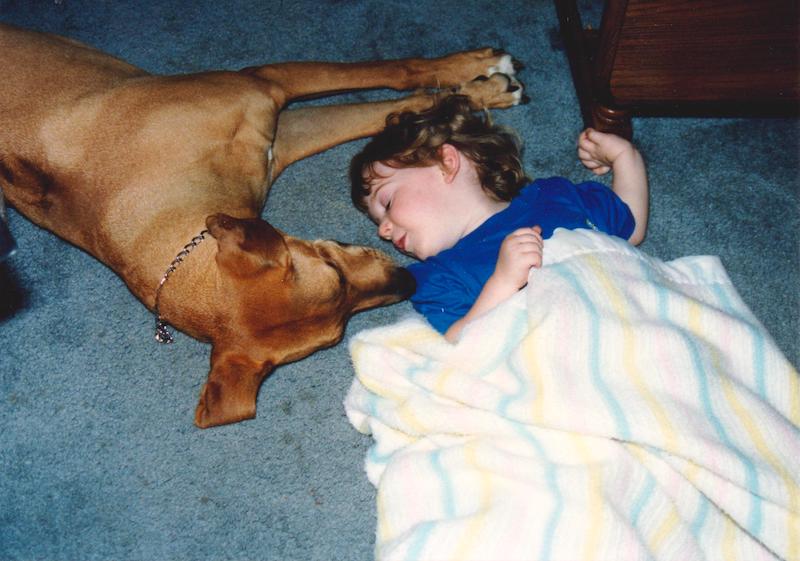
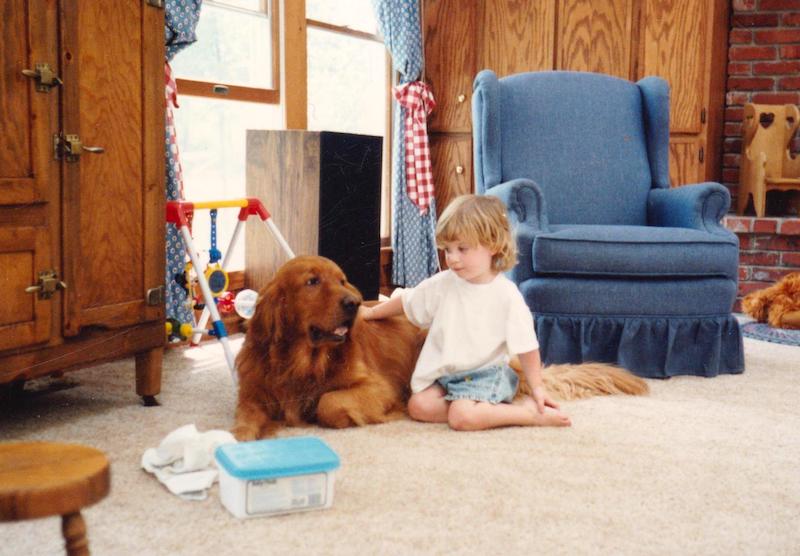
Even five years ago, before I had Remy, if I saw a dog out in public on the street, I would more often than not approach the pup for some interaction.
Ever since I learned the hard truths of having a reactive dog and have educated myself on dog consent, my interactions with other people’s dogs have changed quite a bit.
Today, I rarely approach dogs in public, recognizing that they probably aren’t all that interested in interacting with me (between the exciting new environment and other dogs, I’m at best a nuisance and at worst an intrusion).
I’ve even considered throwing away the shirt I once purchased emblazoned with the words “Life goal: Pet all the dogs” (but the sentiment is still cute, right?).
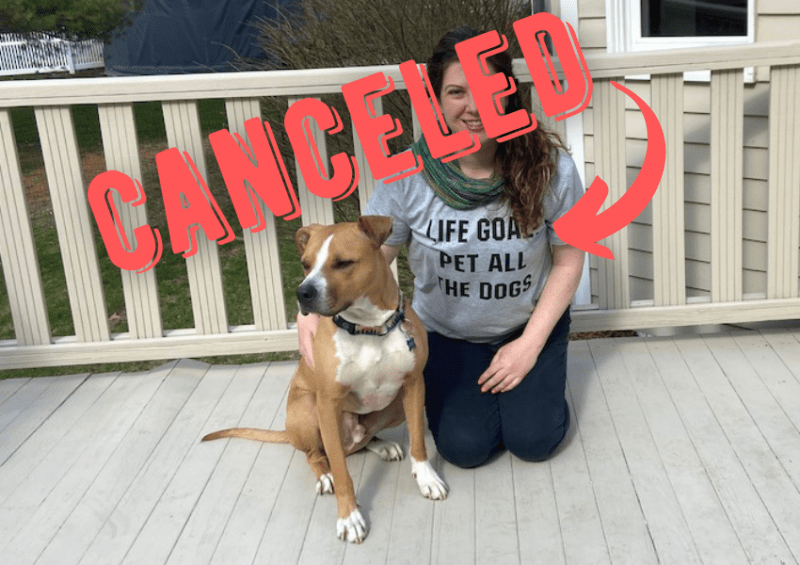
This isn’t to say I’ll never approach a dog. If I see a dog that seems relaxed and not otherwise occupied, I might ask the owner if I can say hello. But honestly, ever since I’ve developed my understanding of dog consent, these interactions aren’t as rewarding.
Why? It’s because I can actively see that the dog usually isn’t interested in me.
He might tolerate my pets, but 90% of the time he really could care less. And while that’s kind of a bummer to recognize, I’m really proud at how much better I’ve gotten at understanding dogs and how they want to engage with the world around them.
Canine consent was definitely not something I ever seriously thought about until the last couple of years.
Why Does Dog Consent Matter? Why Are Dogs Special?
Having established that dogs can clearly decide whether or not they want to partake in a given activity (and that we should care about their willingness to do so), it is important to consider another issue: Why do we care about our dogs’ ability to consent to interactions, while ignoring the same issue for so many other animals?
After all, many – if not most – sentient beings have the ability to provide consent. As humans, we just don’t often care if animals consent to our handling of them or our interactions with them.
There are many, many animals whose consent we disregard on a regular basis. And while some parties will argue that that’s never OK, most of us have accepted that in order to live within a certain degree of comfort, we’ll have to kill some animals who do not want to be killed.
And, while many of us won’t respect a farm animal’s desire to not be slaughtered, most of us are still behind giving these animals a life that is more humane, involves some degree of autonomy, and is closer to how they might live naturally.
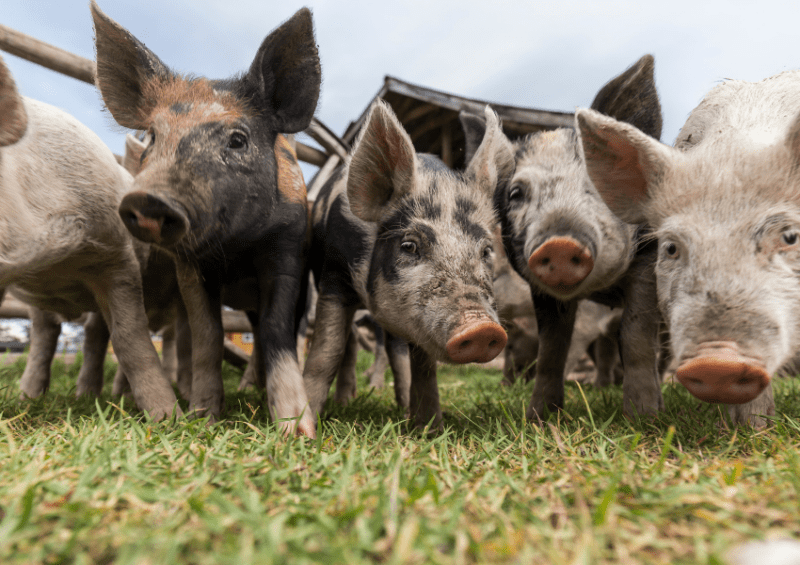
So, if we regularly disregard the consent of so many animals, what makes dogs different? Why should we seek their consent when we fail to do so for so many other animals?
Many may argue there is no difference between a dog’s ability to give consent and a pig’s, cat’s, or bird’s capacity to do the same.
One major difference is that we’ve developed a truly unique relationship with dogs. And that relationship has become much more emotionally loaded and meaningful in the last decade, as younger generations have increasingly come to view their pets as four-footed children and begun taking their pet parent responsibilities more seriously.
This is a dramatic shift in how humans have historically viewed dogs.
Humans originally viewed dogs as utilitarian possessions. We lacked the time and surplus resources to worry much about the inner lives or happiness of the dogs we lived alongside.
Dogs helped our early ancestors catch food, frighten away predators, and stay warm at night. That’s all we wanted them to do, and the care we provided them was focused on helping them perform these tasks. We fed them and provided for some of their basic needs, so that they’d remain healthy enough to fight bears and chase down rabbits.
But things have changed a bit over the last 30,000 years or so.
Working doggos aside, we no longer require our dogs to perform these kinds of tasks. Nor do we view our dogs as mere possessions (even if the law has lagged behind society in this regard).
Instead, we now view our dogs as bona fide members of the family.
We take them on vacation with us, we give them birthday presents, and include them in family photos. We share their antics on social media in the same way parents share their children’s latest escapades, and we make special accommodations for their diet and health needs as we would the two-footed members of our families.
Simply put, we care about our dogs’ happiness and overall well-being – including the psychological and emotional aspects of their lives.
This is obviously a good thing. People and their pets are surely happier in the modern world than they’ve ever been before.
But in the pursuit of maximum mutt happiness, we have to alter our approaches to canine care. We have to think about things we’ve previously ignored and be willing to question our prior practices.
And one of the things we need to question is whether or not our dogs want to do some of the things we expect them to do.
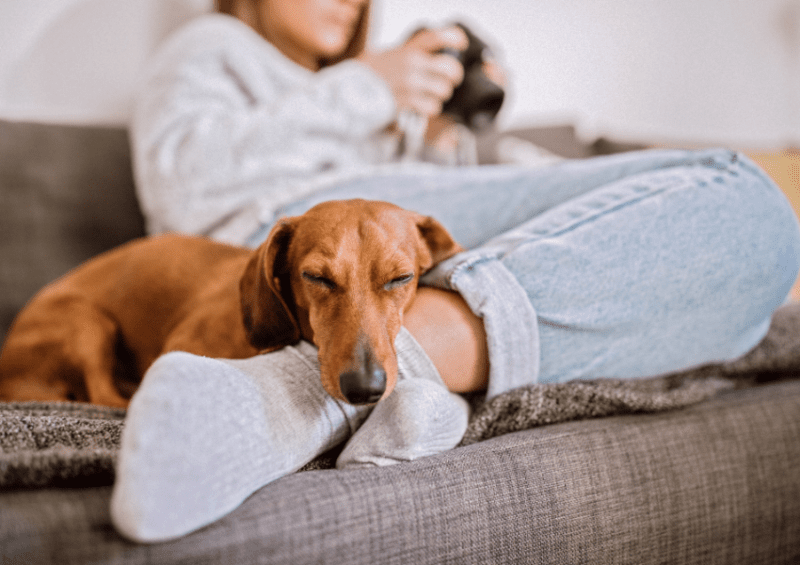
To be clear, dogs are not people, but they are indeed sentient beings with a wide range of emotions.
I am not arguing that dogs experience the same kind of inner complexity that humans do. But dogs most definitely have feelings and emotions, and many of them are quite similar to our own.
Just like humans, dogs experience emotions like fear, anxiety, and joy. Also like humans, dogs need to be able to make choices and have control over their environment to feel safe and content.
As psychology professor and behavior expert Dr. Susan Friedman notes:
“The single most important thing I have learned over 40 years studying learning and behavior is the benefit of giving animals control over their own significant life events. Although it may seem counterintuitive given our cultural fog, research demonstrates that control over consequences is a primary reinforcer, meaning it’s essential to survival like food, water and shelter.”
Many – if not most – sentient beings need to feel safe in order to thrive. Dogs are no exception, and recognizing and respecting their consent is a key way we can offer them security and safety.
Interestingly, the way we usually engage with cat consent is much more straightforward than with dogs. This is largely due to the fact that cats do not tolerate anyone infringing on their autonomy – and they are extremely vocal about it!
Cats are liable to hiss, scratch, and even bite you quite quickly if you touch them against their will. Thankfully, these conflicts rarely do serious damage to humans (sadly, the same can’t be said of dogs, which makes the stakes much higher). Since cats are such firm and vocal advocates of their comfort zone, cat owners often quickly learn how to read and respect their cat. There’s a reason why cat parents tend to have a pretty nuanced understanding of consent!
Canine Body Language: A Crucial Component of the Consent Question
Before delving further into the subject of canine consent, it’s important to keep in mind that the only way you can acknowledge your dog’s consent is by being able to recognize how your dog would express his willingness or reluctance to engage in an activity.
And unfortunately, this can be a bit tricky.
Many people don’t understand how to recognize or interpret things like canine consent because dogs communicate very differently from humans. And this even includes those who absolutely adore dogs.
Their “language” is entirely foreign to us. And no, I don’t mean that you need to translate your dog’s barks to understand what’s in your pup’s head.
Dogs don’t use verbal language to communicate — they use physical cues instead. And some of these cues are very subtle to humans, who rely much more on verbal language.
Dog body language can be so foreign to us that we often misinterpret a dog’s signals, or use simplified language to explain what is actually a much more complicated or conflicted inner state.
A wagging tail is a perfect example.
I’m sure as children most of us have heard at one time or another that a wagging tail indicated a happy, friendly dog.

In actuality, a wagging tail conveys a much more complicated and nuanced message: It signals that the dog is in an excited state.
And while this excitement can be a friendly response, it can just as easily be an indication of conflicted arousal that can easily tip over into aggression.
The speed, direction, and angle of a dog’s wagging tale can provide additional clues as to whether you’re approaching a happy, unsure, or aggressive dog. But to simply say that a wagging tail means a dog is friendly isn’t just inaccurate;- it’s actually a downright dangerous misconception!
If you don’t know much about dog body language, you’ll likely be quite surprised at just how effectively dogs can communicate their inner emotions through their ears, tail, and even their facial expressions.
We have a full dog body language guide I’d encourage you to check out, but here are some of the easiest body language cues to spot:
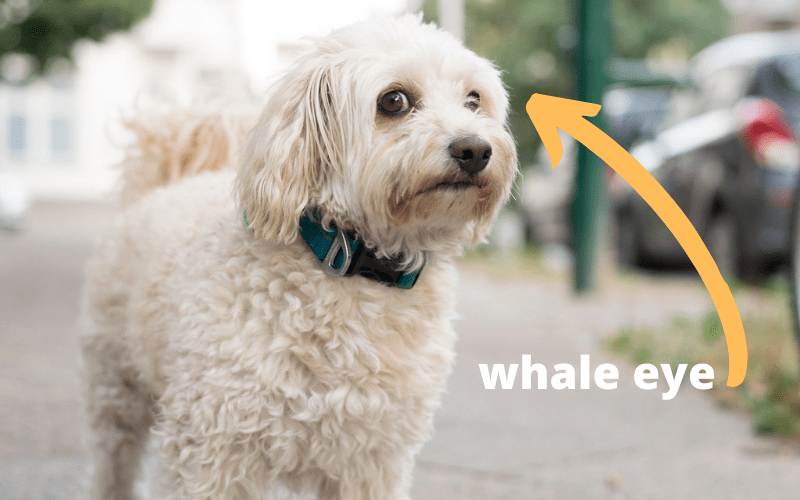
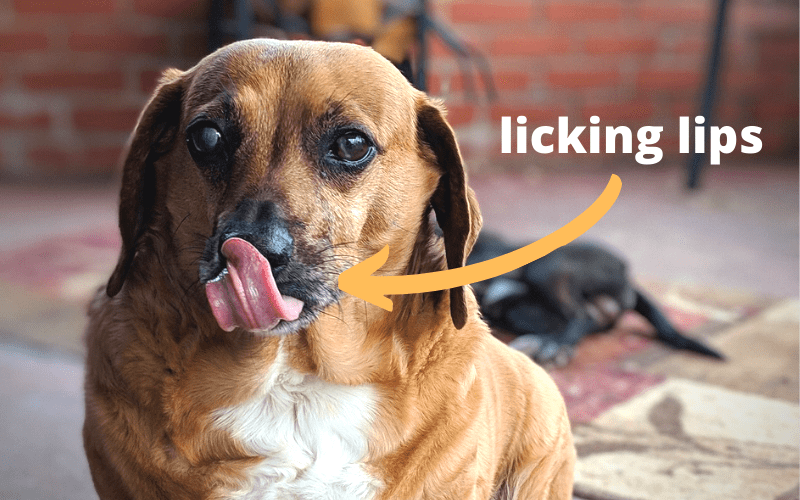
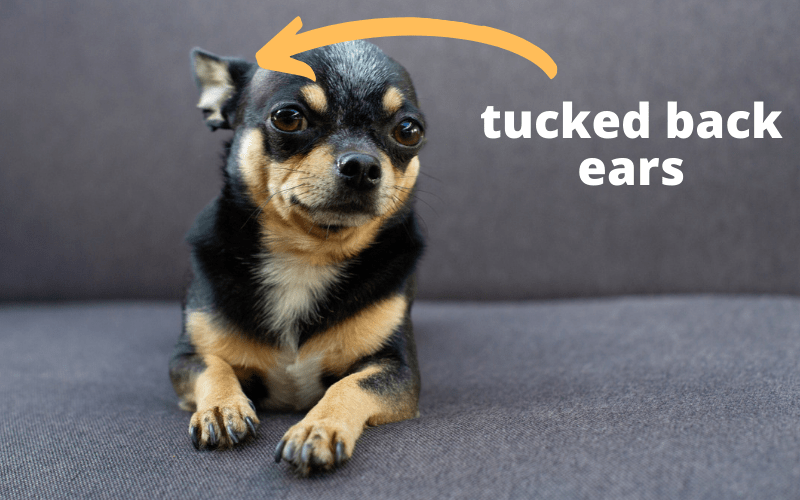
Now, those are all some basic examples of the ways in which a dog can communicate simple emotions. But what about more complex concepts, such as consent for petting? How can you interpret your dog’s willingness to be touched?
One of the best ways is via a simple training game or exercise, which we’ll explain in the next section.
Pat, Pet, Pause: A Dog Consent Game
One of the easiest ways to test canine consent is through the “Pat, Pet, Pause” exercise, developed by Justine Schuurmans of The Family Dog.
I highly encourage you to teach this game to any children in your household and practice this game yourself!
- Step 1. Pat your knee or thighs in order to invite the dog to come over to you for pets. If the dog doesn’t approach, do not continue. If the dog doesn’t approach, the exercise is already over, and the dog has clearly communicated that he does not want to interact with you right now.
- Step 2: Assuming he comes over to you, reach out your hand to pet the dog on a non-threatening area of the body, such as the chest (most dogs don’t like being petted on top of the head – it’s quite intimidating having someone reach up and over your head).
- Step 3: Pet the dog gently for a few seconds.
- Step 4: Pause your petting and float your hand a few inches away from the dog (or take your hand away completely).
- Step 5: Watch and see what the dog does. Does he look at you in a request for more? Does he lean towards you or push himself against your hand? These are all signs of consent for more pets! Conversely, if the dog looks away, gets up to leave, or does nothing at all, he’s not interested in getting scritches.
Once you’ve received permission for a chest scratch, you can go on to repeat the process for other areas of the dog you’d like to pet. Just make sure to pause periodically and evaluate the dog’s comfort level with each area you’re petting.
More of a visual learner? Check out our Pat, Pet, Pause illustration graphic below!

Canine Consent Changes: Dogs Can Withdraw Consent at Any Time
Remember that consent can change!
Your dog might be fine with being scratched on the butt for 10 seconds, but a full minute might be too long. This is why you should constantly be pausing and waiting for your dog’s response, even if your dog was happy to be scratched a minute ago or you’re touching him in an area he’s normally fine with.
Another key aspect of this exercise is that you must always let the dog come to you.
Don’t approach a dog while he is sleeping or resting in his crate. Yes, we know dogs look darn cute when they’re sleeping. But most dogs don’t like being touched while snoozing any more than you do.
Canine Consent Isn’t Always Crystal Clear: What Do You Do When You’re Not Sure What Your Dog Wants?
Practicing Pet Pat Pause with my own dog, there have been many situations in which he’ll simply sit there. He won’t move or look away, nor will he move towards me. He just stays completely still.
This can leave owners wondering what to do. Do you continue petting him or do you stop?
Based on the Pat, Pet, Pause protocol, this means he does not want to be petted.
Your dog’s reaction to the petting consent test should always be unambiguous. We should always be seeking an enthusiastic “yes, more scritches please!” response.
If your dog doesn’t offer such a response, he’s essentially telling you “no thanks.”
And as loving owners, we must respect the “no!” We should even respect the “I’m not so sure” answer.
Your Dog Might Be Saying “No Thanks” A Lot More Than You Think
When we broaden ourselves to listen to consent from our pets and other animals, we have to be willing to accept a “no” answer.
The sad truth is that many people are uninterested in canine consent because asking for permission will often mean that the person won’t get what he or she wants.
Contrary to what most of us have been raised to believe, many (maybe even most) dogs don’t have any interest in interacting with strangers.
They may like being cuddled by family members, but they do not want a stranger rubbing them all over.
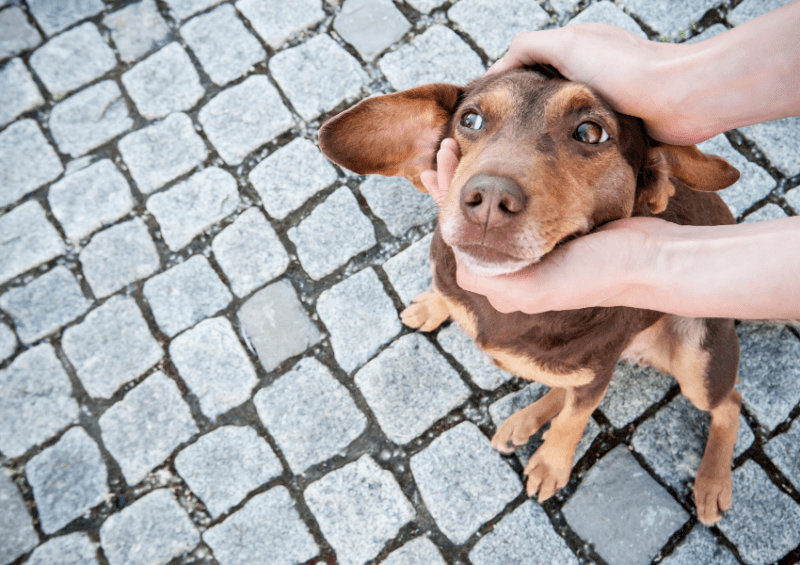
And that’s not really such a huge surprise, is it? Most humans probably wouldn’t enjoy being touched by strangers.
It seems especially obvious when we think about dogs objectively as animals rather than in conjunction with the mythological status we’ve projected onto them as “man’s best friend.”
They’re sentient beings with needs and desires of their own – they aren’t puddles of docile compliance, which exist to do our bidding.
A Story About How I Misunderstood Dog Body Language
I remember when I visited Austin Animal Center (AAC) three years ago with the intention of bringing home a dog. Unfortunately, I was offended by how many dogs didn’t really want anything to do with me.
I zeroed in on a dozen potential adoptees that I had found online when searching the shelter’s adoptable dog database, and went to visit them in person. One by one, I took each dog out of their kennels and into one of the large grassy exercise pens the shelter has. I would let the dog off of the leash and see what they’d do next, hoping for them to come up and cuddle with me affectionately.
The vast majority of dogs immediately lopped off away from me, sniffing the perimeter of the fence and completely ignoring me. They didn’t seem very excited by my presence at all.
I, in my great wisdom, decided that this meant these dogs would be poor companions for me. I was disappointed by this behavior and decided that I wanted a dog who had been “socialized with humans.” I wanted one who would interact with me more enthusiastically.
While most of the dogs I visited largely ignored me, Remy (my now-adopted dog) didn’t. In fact, he kept coming back to me and chewing on my arm in extreme excitement.
Gee, what could go wrong with that? Spoiler alert: quite a lot.
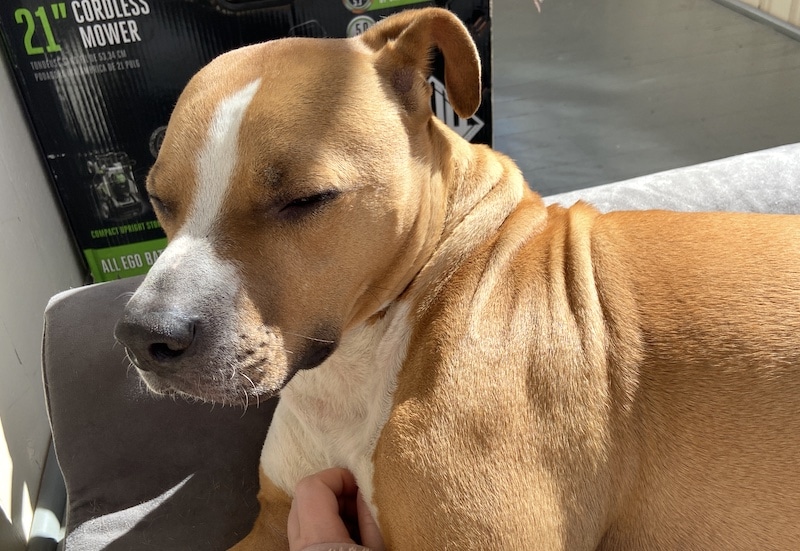
My human ego prevented me from really evaluating this experience from the perspective of the dog. For a dog who has spent days, weeks, or months in the shelter environment, with short, infrequent trips outside of the kennel, this time to roam and smell was coveted gold (in fact, AAC is so often overcrowded with dogs that it’s not unusual for dogs to go entire days without leaving their kennel).
I was just a random, boring human that these dogs had zero history with. Why would any dog be interested in me? I hadn’t given them much of a reason to, outside of some stale dog biscuits.
If I had known then what I know now about dogs, I would have recognized that Remy’s unusually extreme arousal and excitement at my presence was actually somewhat concerning — a calm, more neutral interaction is what one should expect from a well-adjusted shelter dog.
Consent For Family Dogs Matters Too
A lot of us tend to be more careful around strange dogs than our own family dogs. And while our own dogs will usually tolerate a lot more than strange dogs might, they deserve just as much respect and consideration as you might give unfamiliar pooches.
It’s really important to recognize that you don’t deserve 24/7 access to your dog just because he lives under your roof. A family dog deserves just as much autonomy and respect as a strange dog.
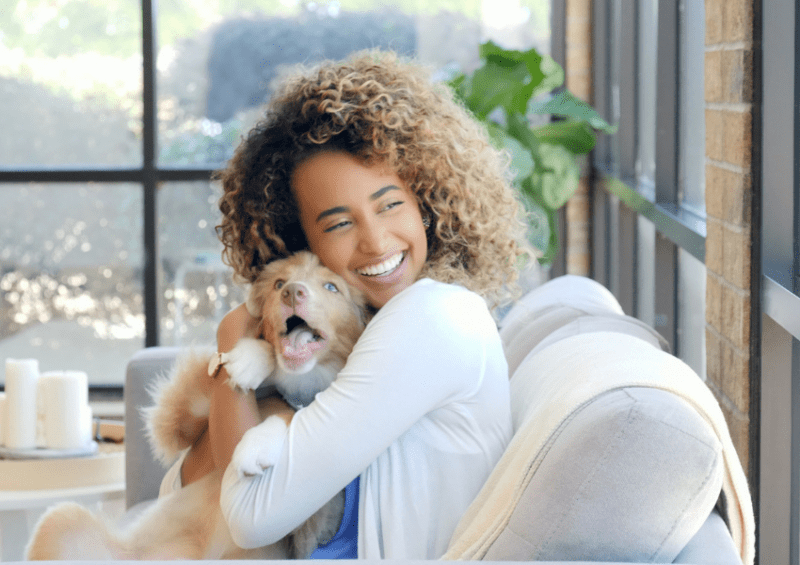
Your family pet will not always want to snuggle with you. And you need to accept that. We don’t get to decide what our dogs are comfortable with. We don’t get to decide their thresholds.
I get it though. Sometimes when Remy retires to bed and abandons me on the couch at 7:30pm when I’m just about to watch TV and am clamoring for some cuddles, I get bummed out.
Sometimes I begin to think to myself “What the heck, Remy? I feed you, care for you, and give you a great life – and now you won’t even cuddle on my agenda?”
But then I catch myself and realize how selfish I sound.
If any roommate, friend, or romantic partner told me they wanted some alone time, I wouldn’t be offended. Heck, as an introvert, it’s not unusual for me to retire to bed early to have some solo reading time.
This assumption that we as humans have certain rights that allow us to lord over our dogs has to stop.
This mindset is also what leads to so many rescue dogs being returned to shelters. We may invite a dog into our home only to bristle when the dog growls as we bend over to pet him while he’s resting, all without recognizing the situation that the dog is experiencing.
He is in a strange environment, he’s scared, he has no idea what is going on, and a stranger is getting in his face when he’s just trying to feel safe.
It’s so important that we give our dogs time to acclimate to new environments and new people. It’s easy to earn a dog’s trust, so long as we are patient and acknowledge their right to consent.
Somehow it’s easy for us to assume that we deserve full control over our companion animal’s lives. But we really and truly do not.
The sooner we accept and recognize that fact, the more compassionate and considerate we can be in all our relationships.
Teaching Animal Consent to Kids
There are so many reasons why it’s important to teach children about animal consent.
Not only does it dramatically lessen your child’s risk of getting bitten by a dog, but it also can help a child understand and recognize their own ability to provide consent or withdraw consent in certain situations.
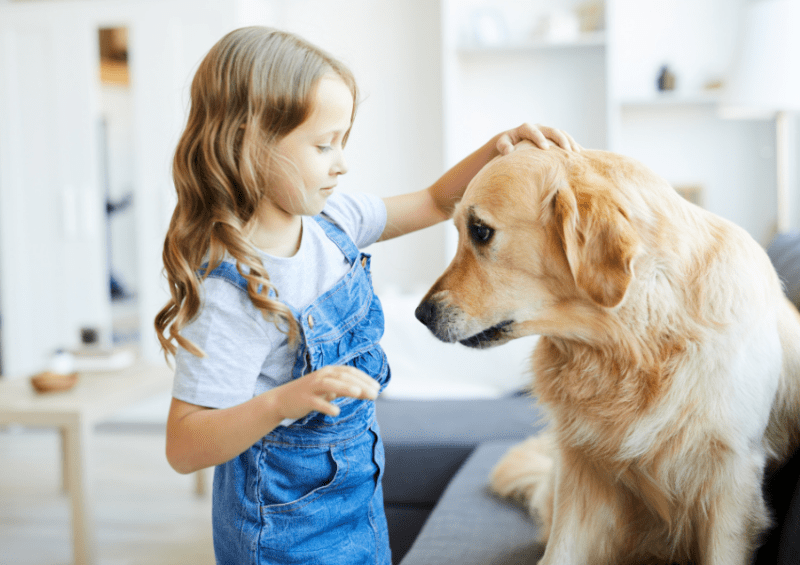
It’s disturbing to admit that children are often taken advantage of in a myriad of ways due to their naivety. Giving your child a chance to practice evaluating and detecting consent in others will give them the tools to recognize and exercise their own consent.
It’ll keep them safe as well as make them better friends and partners to others.
The Romantic Fantasy Surrounding Dogs Hurts Them
There is so much mythology surrounding dogs that it’s very easy to overlook the reality that our dogs are animals. A domestic animal, sure, but an animal nonetheless.
Dogs are not telepathic mind readers. They are not angels from above sent to act as our guardians and keep us safe. They are not a plaything for children to learn about responsibility, and they are often not the happy-go-lucky man’s best friend we’ve been shown in movies and TV shows.
When we endlessly repeat tales about the selflessness, protectiveness, unconditional love, and perfection of dogs, we create unrealistic expectations of these animals that simply hurts them.
Yes, dogs are wonderful, but they are not made to be our meek, tractable lackeys.
Dogs have their own motivations and desires that have nothing to do with the humans surrounding them. In fact, a lot of a dog’s natural motivations are incongruent with what we want from them as family pets. And this is where most of the conflict between dogs and humans resides.
Dogs are all individuals, with their own thoughts, feelings, and perspectives. Each individual dog will have a different comfort level when it comes to physical interactions and engagements with humans.
And if we as a society really love dogs as much as we claim to, recognizing their autonomy and giving them the opportunity to interact with us in a consensual manner is the least we can do for them.
The History of Consent And How It’s Grown in Recent Years
Let’s dive into what consent actually means and how practicing consent has evolved over recent decades.
Some people may balk at the idea that an animal can consent to anything. But consent simply means the ability to give permission or authorization (or withholding the same) in relation to certain interactions.
And while there are a myriad of occasions in which consent is involved in our day-to-day lives, we most often talk about consent in relationship to sex – mostly because sex performed without mutual consent is one of the most traumatic and violating actions someone can experience.
Part of the reason why we talk about consent so much in terms of sexual intimacy is that the social signaling and performance around dating, physical intimacy, and sex have long been muddled and murky.
Ideally, we should always shoot for enthusiastic consent with our intimate interactions, but coercion is not uncommon, and has been a powerful tool humans (men in particular 😬) have used for a very long time.
The taboo around even talking about sex and physical intimacy has created a ripe ground for coercion. If we don’t talk and compare sexual experiences, don’t discuss boundaries, and consider words like “yes” and “no” unromantic, it’s incredibly easy for coercion to take place.
And that’s likely by design.
It’s still generally considered unsexy to ask for permission to kiss someone. But why exactly is that? I can’t help but question if this idea has been perpetrated by elements of the patriarchy who didn’t want to be bothered worrying about a woman’s interest or lack thereof.
In a time where most of us can agree that more communication is always better and reduces one’s chances of being misunderstood, the stunted use of communication around physical intimacy is problematic and dangerous for all parties involved.
The topic of consent is also tied so much to sex because, as an extremely intimate act that has various stages of progression, an individual’s level of consent can change moment to moment.
Because women are so often the ones being persued for sex in heterosexual relationships, they are often the ones in charge with offering or retracting consent. That doesn’t work in the patriarchy’s favor, which is why for many years the responsibility was put on women to dress chaste and not cavort unchaperoned with men.
The prevailing belief was that assault was almost always the women’s fault, with a women’s consent or lack of consent being completely null and void. If you dressed scandalously or hung out in the wrong parts of town and were assaulted, you only had yourself to blame.
Whether or not you did ask for it, you had, in fact, “asked for it.”
Consent for women has been so disregarded that marital rape wasn’t even considered a crime until the 1970s in the United States, and it wasn’t until 1993 that all states eliminated the “marital rape exception.”
And unfortunately, the UnitedStates still has a long way to go as women continue to fight for their autonomy and bodily consent when it comes to abortion.
The good news is that women have become more outspoken in more recent years about how often their consent has been disrespected in response to the upheaval surrounding the “Me Too” movement.
And as our society has become more willing to vocalize the questions and subtleties surrounding consent, we’ve also become more open to recognizing animal consent as well.

We Already Know What Consent Is For Humans: We Can Apply it to Dogs Too!
We learn at an early age that humans deserve to have their consent respected.
As children, we learn we can’t just take another child’s toy without asking. As adults, we don’t touch a stranger’s hair, pat them on the head, or touch them at all without consent.
Imagine that someone you’ve just been introduced to reaches out and rubs your arm tenderly, and then proceeds to hug you close against them while they stroke your back. They hold you tightly, even as you try to pull away and cry out for them to stop.
That would be pretty disturbing right?
Well it’s disturbing for dogs too!
It’s honestly a wonder we don’t have more dog bites considering the complete disregard many humans have towards a dog’s physical autonomy.
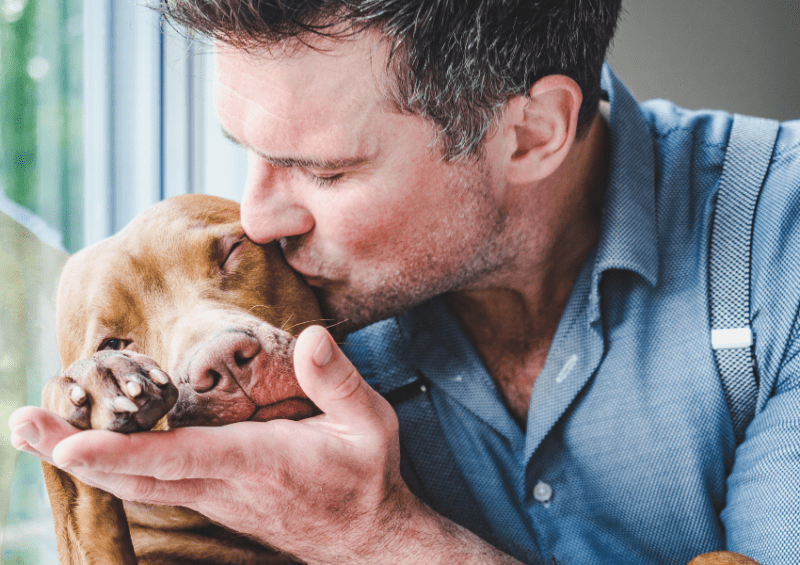
Enough stories have come out in the news of politicians performing awkward lower back rubs and uncomfortable cheek kisses. The conflict surrounding what kind of behavior is or is not appropriate is, in some regards, a generational one — many older men grew up in a time where young women’s consent wasn’t valued or scrutneized as heavily.
While the offense is not intentional, these physical interactions make many women uncomfortable. We may be able to forgive older politicians for not knowing better (or we won’t – that’s completely up to you), but it’s important to recognize that even as humans we have difficulty navigating physical consent within our own species.
And we have verbal language on our side!
Acknowledging Dog Consent Means More Safety and Fewer Bites
Respecting our dog’s consent isn’t just important for developing a healthy relationship with our pet. It’s also how we can drastically reduce our chances of being bitten!
Once you learn how to read dog body language, it becomes much easier to evaluate a dog’s consent. Want to pet that dog waiting outside CVS for his owner? If you approach and the dog looks away, displays “whale eye,” or puts his ears back, the dog is displaying signs of discomfort and is not consenting to your attention.
Congratulations, you’ve avoided one more situation that could have potentially invited a dog bite!
Remember that asking a pet owner for consent to pet his or her dog doesn’t necessarily mean you’re all-clear either. The human might not mind if you pet their dog, but the dog might not agree at all!
Due to the lack of education most of us have in regard to dog body language, many owners aren’t even aware of their own dog’s comfort level with physical contact from strangers. This is why being able to evaluate dog body language is so darn important!
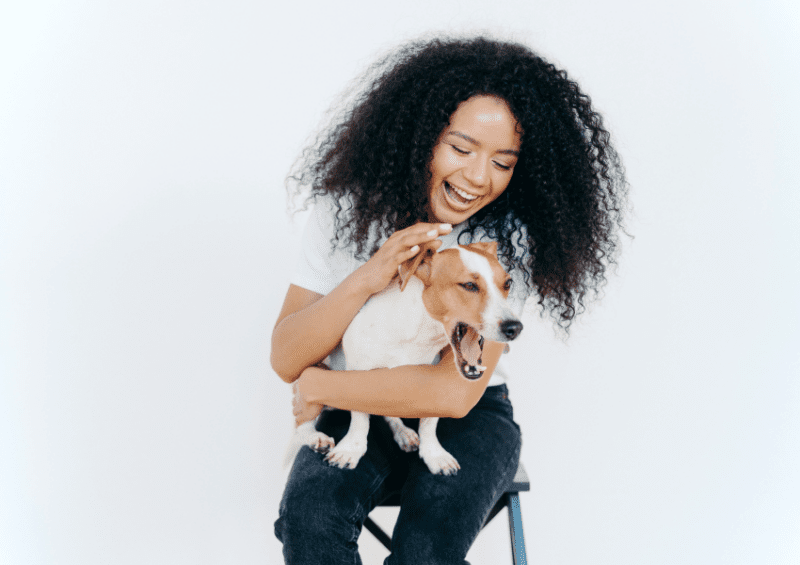
Respecting our Dog’s Consent Is Inconvenient, But It’s the Right Thing to Do
It’s not really a surprise when some people deny their own dog’s ability to provide consent. After all, respecting a dog’s right to consent is inconvenient. It gives up some of your control.
And sadly, there are far too many people who opt for dog ownership largely due to the ego boost they receive for controlling another living being.
For these people, it’s much easier to laugh off the idea of dog consent than listen to what their dog has to say. Just as it was once easier to pretend wives didn’t have the ability to deny consent to their husbands in the bedroom.
Respecting our pets’ consent can also just be kind of a bummer sometimes. We all love dogs, and hugging and petting dogs is super fun. But that doesn’t mean we deserve to express our love of dogs to unwilling participants!
As the saying goes, “maybe he’s just not that into you.”
And that’s OK!
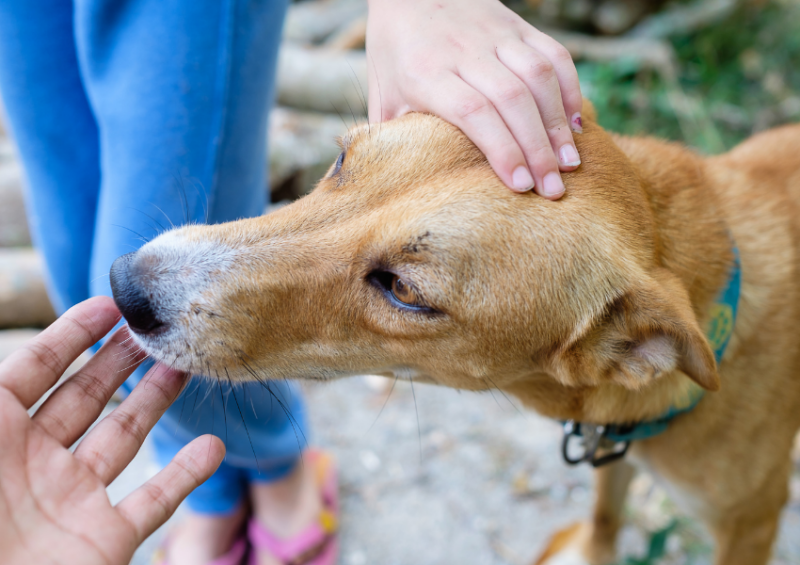
You Can’t Always Get Your Dog’s Consent, But You Can Try
At times it can be really inconvenient to respect your dog’s consent. Maybe your niece is visiting and she really wants to pet your nervous dog who wants nothing to do with her. These are situations when we really need to stand up and advocate for our dogs, even if it disappoints some people.
But other times, respecting your dog’s consent is downright impossible.
In some situations, you may have to disregard your dog’s consent entirely for his own good, such as when it comes to:
- Grooming
- Vet visits
- Medical situations
- Dogs who want to play with another dog who is frightened or aggressive
- Eating something on the ground that’s dangerous
Most owners will agree that when it comes to safety issues, medical care, and emergencies, our dog’s consent isn’t going to be requested. If my dog and I are trapped on the roof of a flooded building and a helicopter comes to save us, I’m hauling my dog’s butt into that helicopter no matter how he feels about it.
However, it’s worth noting that there’s a lot we can do to increase our dogs’ likelihood of opting into an experience they might normally not consent to.
This is largely practiced through desensitization.
How Desensitization Can Increase Pet Consent
Dogs are naturally fearful of new and novel experiences, but when we take the time to get them more comfortable with scary situations, they’ll be more likely to consent to whatever we’re trying to accomplish.
And that includes a variety of different dog grooming and husbandry care tasks in which obtaining your canine’s consent can not only improve your relationship with your pet, but just make things easier too!
For example, your dog may squirm away while you try to put a harness on him because he’s never worn one before. He may plop down and refuse to move once leashed up because he’s never been on a tethered line before!
We can increase the chances that the dog will consent to being harnessed and leashed by desensitizing him to the process via a series of slow, gentle steps.
You might start out showing the dog the harness and offering him a few treats. Then, let him sniff the harness while providing treats. Next, you could hold the harness up and invite the dog to simply stick his head through the head hole to grab a treat, while allowing him to dart back once he’s done.
Yes, this requires patience and takes more work than holding down your dog and shoving the scary contraption over him. But moving slowly at your dog’s own pace will allow him to trust you while helping him build his confidence.
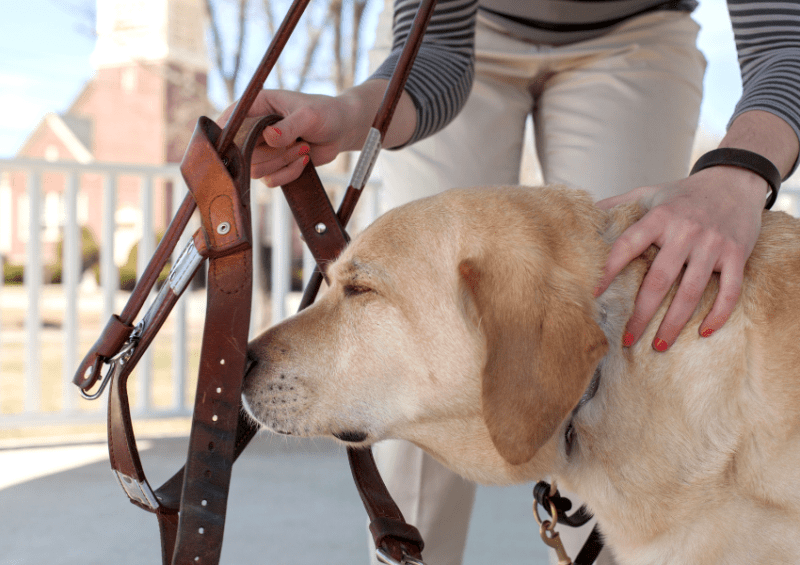
Before you know it, your dog will be consenting to harnessing without any issue! And this same mindset and approach can work in myriad situations:
- For grooming events, you may need to offer up some treats while slowly desensitizing your dog to nail trimmings at home so you can take it one step at a time.
- For vet visits, it might mean taking your pup for fun trips to the vet’s office for attention and treats before forcing him to endure any unpleasant or scary medical procedures.
- When trying to prevent your dog from eating something off of the ground, it might mean establishing a solid “leave it” cue that rewards your pup with something even tastier than the trash on the street.
We can’t always accept our dog’s consent, but there’s still a lot we can do to increase the likelihood of a dog opting in.
Listen To Your Dog’s Consent: He Will Trust and Respect You More
We’ve talked a lot about how respecting dog consent can keep you and your loved ones safe from dog bites, and how respecting our pets’ autonomy is a kindness our furry family members deserve.
But there’s another huge advantage to respecting your dog’s consent — your dog will trust and respect you much more.
We already control so much of our dogs’ lives. We control when they go to the bathroom, when they eat, where they walk, what they play with, who they are exposed to.
As Jenny Efimova of Dogminded notes “conventional dog training reinforces this imbalance and encourages us to use power and control as the model of how to relate to our dogs. But just because things have always been this way, doesn’t mean they have to be.”
Just because we can force our dogs to submit to our will doesn’t mean it’s right. Coercion shouldn’t play a role in any meaningful relationship — whether it’s in relation to friends, lovers, children, or our pets.
The truth is, we aren’t always going to be able to acknowledge our dogs’ consent. But we can do our best to advocate for them, respect their needs, and recognize when they are uncomfortable with a given situation.
Interested in other animal-welfare issues? Check out 52 disturbing animal-testing statistics.
How do you treat your pets in regards to consent? Do you have difficulties determining your pet’s level of consent in different situations? Share your thoughts and experiences in the comments below.
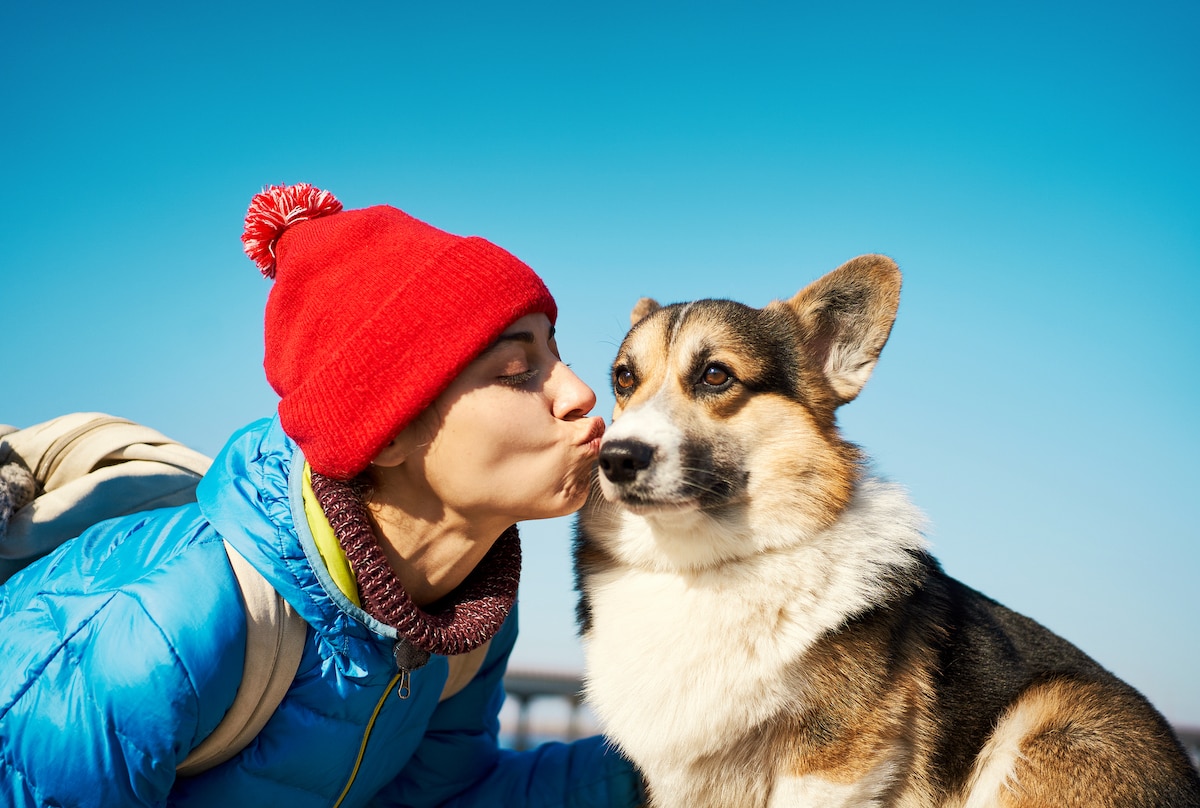







Leave a Comment